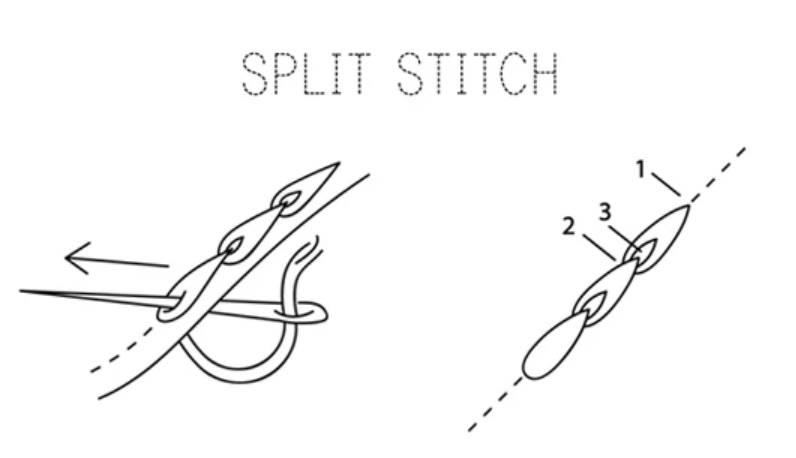Hand Embroidery for Beginners
Welcome to this handicraft tutorial where you can get many essential hand embroidery stitches. Whether you are starting this technique or looking to expand your skills, this all in one tutorial will guide you through a variety of stitches from basic to advanced.
Running stitch: the most basic stitch used for outlining and adding texture. Simply weave the needle in and out of the fabric in a straight line.
Back stitch: perfect for outline and fine details create a line by bringing the needle up and back into the previous stitch hole.
Split stitch: its used for outlines and filling create a back stitches and bring the needle up through the center of previous stitch.
Chain stitch: Its great for outlines and decorative lines make a loop and secure it with a small stitch.
Couching stitch: Secure thicker threads that lay a main thread on the fabric and tack it down with small stitches.
Stem stitches: commonly used for stems and outlines make small diagonal stitches that overlap slightly.
French knot: French not adds texture and details, wrap the thread around the needle and insert it back into the fabric close to the starting point.
Cross stitches: popular for patterns and designs make x shaped stitches on a grid.
Double cross stitches: its add complexity to cross stitch make a cross and another cross over it.
Fishbone stitches: its ideal for leaves make overlapping diagonal stitches to form a fishbone pattern.
Lazy daisy stitches: its ideal for petals and small leaves. Its form a loop and tack it down with a small straight stich
Satin stiches: its perfect for filling stich. Its make parallel stitches closely together to fill the whole area.
Fly stitches: its use for make pattern and texture can be use for leaves and it make a v shape with a small stitch at the top to hold it in place
Bullion knot: its use for the decorative details, its thread around the needle multiple times before inserting it back into the fabric.
Pekinese stitch: its a combine package of back stitch and loop stitch for creating a braided effect. Back stitch a line then weave the thread through the stitches.
Herringbone stitch: its great for borders and fillings, make Criss crossing stitches to create a herring bone pattern
Whipped back stitch: its adds texture to back stitches. Whip the thread around each back stitch without piercing the fabric .
Cretan stitch: its used for filling and borders , make alternation stitches at an angle creating a zigzag pattern.
Heavy chain stitch: this is a heavy or thick looking chain stitch . it gives out a rich feeling depending on the thread used to stitch.
Woven wheel stitch: creates a raised circular shape weave the thread over and under foundation stitch.
Feather stitches: its looks like a feather. And its use for decorative and great of border and make a series of v shaped along a line.
Spider web stitch: it forms a raised circle make radial stitches. And weave the thread around them in a spiral.
Long and short stitches: its perfect for shading. Its create a smooth gradient.
Sheaf stitch: its also a decorative stitches. Make three parallel stitches and tie them together in the middle.
Knot stem stitch: its add texture to stem stitch, and make a stem stitch and add knots along the line
Chevron stitch: its great for borders and, make a series of v shape stitches along a line.
Woven picot stitch: its create 3D petals and make a foundation stitch and weave the thread over it.
Sobell stitch: for make a small squares and make a cross stitch and wrap the thread around the intersection.
Cable chain stitch: it adds texture . its make a chain stitch and twist the thread around it
Palestrina knot: its use for texture, its make a knot by looping the thread and pulling it through
Cast on stitch: its crate raised texture loop by wrapping the thread around the needle multiple times before pulling it through the fabric its perfect for creating floral elements .and also the texture lines.
Knotted loop stitch: its use for add texture. Make a loop and tie a knot at the top
Rosette chain stitch: its use for decorative and textured make a chain stitch and loop the thread around it.
Drizzle stitch: its use for height and texture. Make a long loop and anchor it with a knot.
Twisted chain stitch: its variation of the chain stitch where each loop is twisted before securing it to the fabric giving a decorative repel like appearance. Its ideal for borders and decorative lines.
Basque stitch: its similar to a chain stitch. But with a twist make a loop and secure it with a small stitch. its continue in a chain like fashion with twisted loops.
Vandyke stitch: its also use for borders and decorations and also filling or make patellar vertical stitches and weave the thread horizontally through them
Shell stitch: its great for borders . it can make a series of overlapping scallops.
By understanding and mastering all types of stitches, you can create a wide range of effects and bring your embroidery projects to life with greater detail and dimension.
You can get all stitches from this video
I have another post about stitching , you can read this here.






